XSA Labs Vanguard Bookshelf Loudspeakers by Greg Voth
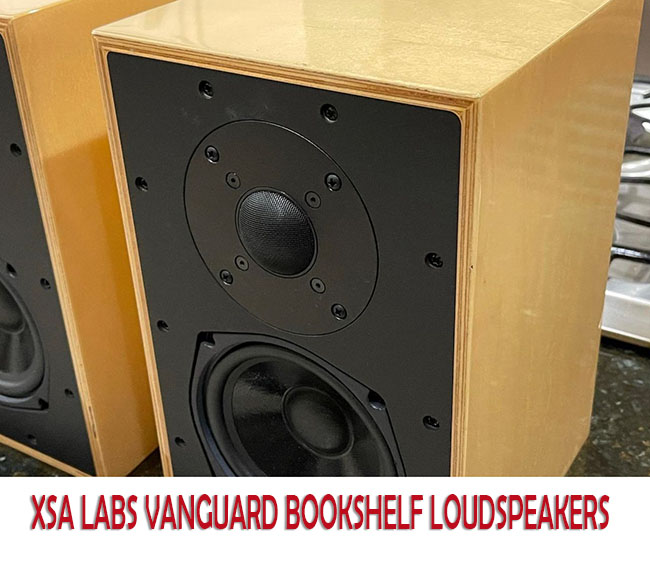
 I first met Viet Nguyen when I reviewed his LSA Discovery Warp 1 power amplifier for Walter Liederman’s Living Sound Audio brand (LSA), sold direct at UnderwoodHiFi.com. At that time, we spoke primarily about amplification and his Warp 1 Class D amp, which I greatly liked. The Warp 1 remains a significant step forward in Class D amplifier sound reproduction and is the best Class D I’ve heard under $1999. Now I’m here to tell you about his new Vanguard Bookshelf Speaker. Nguyen is an audio superman, though I doubt he’d describe himself in that manner. He MIGHT be super in his daytime role as an engineer who is a weather satellite program manager… but I like to think that it’s at night when he’s designing unique things for lovers of audio, from amplifiers, preamplifiers, phono stages to speakers that’s when he’s super.
I first met Viet Nguyen when I reviewed his LSA Discovery Warp 1 power amplifier for Walter Liederman’s Living Sound Audio brand (LSA), sold direct at UnderwoodHiFi.com. At that time, we spoke primarily about amplification and his Warp 1 Class D amp, which I greatly liked. The Warp 1 remains a significant step forward in Class D amplifier sound reproduction and is the best Class D I’ve heard under $1999. Now I’m here to tell you about his new Vanguard Bookshelf Speaker. Nguyen is an audio superman, though I doubt he’d describe himself in that manner. He MIGHT be super in his daytime role as an engineer who is a weather satellite program manager… but I like to think that it’s at night when he’s designing unique things for lovers of audio, from amplifiers, preamplifiers, phono stages to speakers that’s when he’s super.
This audio designer has an exciting approach to loudspeaker construction. Nguyen first conceives a design on a foam board using hot glue. When he shared this prototyping idea with his friends on a DIY audio site, he was criticized, as they thought there would be too much vibration and distortion… but Nguyen persisted. He says his prototype loudspeakers measure well and sound surprisingly good, imparting the essential quality of the intended audio design. If the design calls for a constrained layer construction, Nguyen adds silicone caulk between two layers of foam board. Once in the crossover design phase, Nguyen uses software to simulate the component synergy, which he says gives him a very good idea of a final result’s effectiveness. Even so, Nguyen spent many hours tweaking the final design for best use. Out of the 50-100 designs, he’s tried, He currently has about 30 unique foam prototypes in his studio storage.
While Viet Nguyen’s only been involved in audio for the past nine years, he’s established quite a pedigree on diyaudio.com. He runs design thoughts by his followers, sharing designs for the feedback users provide once they’ve DIY’d his designs for themselves. From circuit boards to complete kits and speaker schematics to his fully assembled floor stander, Nguyen has established a broad footprint in the DIY space. His work with LSA has expanded the availability of his commercially available components. Viet Nguyen designed the LSA Signature 50 speakers, now receiving rave reviews, like Terry London’s here on ST, calling that speaker a “disruptive product” for its ability to outperform considerably more expensive speakers.
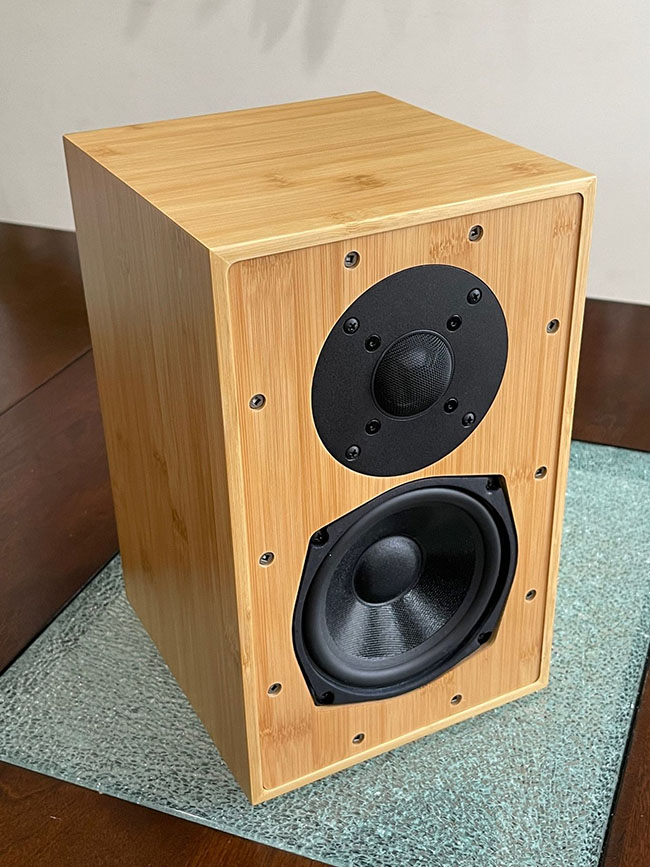
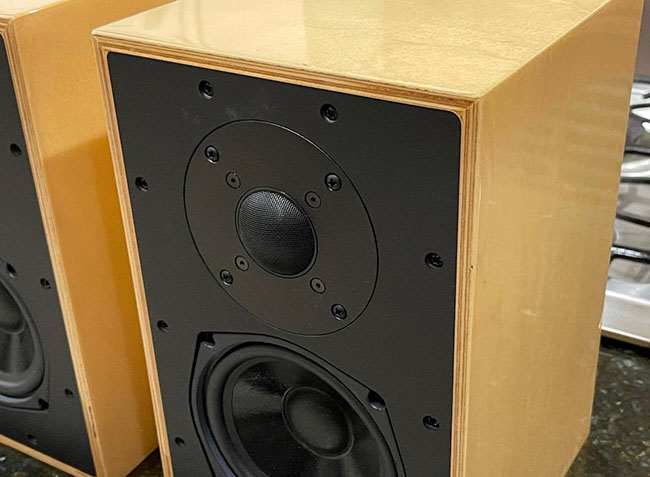
eXtremely Sexy Audio
 Nguyen’s latest venture is XSA Labs (www.xsa-labs.com), a direct-to-you business model where his components can be purchased. Quoting from the homepage, XSA-Labs will “offer unique, innovative, and leading-edge products for the very best in SOUND QUALITY [caps theirs] and value using state of the art design and manufacturing technologies.” The site notes that XSA Lab’s design and management team is both agile and forward-thinking, with over 110 years of combined experience in the audio, electrical, and aerospace engineering fields.
Nguyen’s latest venture is XSA Labs (www.xsa-labs.com), a direct-to-you business model where his components can be purchased. Quoting from the homepage, XSA-Labs will “offer unique, innovative, and leading-edge products for the very best in SOUND QUALITY [caps theirs] and value using state of the art design and manufacturing technologies.” The site notes that XSA Lab’s design and management team is both agile and forward-thinking, with over 110 years of combined experience in the audio, electrical, and aerospace engineering fields.
His latest speaker, the Vanguard, can be viewed and purchased directly, along with other audio components. Mark Schifter is his partner and collaborator on this journey – I’ve felt Schifter’s presence since his involvement with Audio Alchemy and Genesis speakers back in the early 1990s. Still, it wasn’t until I reviewed the Emerald Physics EP 4.7 open baffle loudspeakers that I met the man. It was Schifter who ran across Nguyen on that DIY site and brought him to the attention of the folks at LSA. The rest, as they say, is audio history.
If you go to the XSA Labs home page, a scroll of the page will show you Nguyen’s first two products available there, the Vanguard speaker and the Series One A25 Class A power amplifier. The first shipment of the Vanguard should be arriving and available for sale by the end of August 2022. While the Series One A25 amp is not yet available, its’ preview photo indicates an eminent arrival.
The BBC licensed Rogers LS 3/5a.
A reinterpretation of the BBC licensed Rogers LS3/5a; the Vanguard Bookshelf Speaker is a sealed box design, like the original, that will be instantly familiar to those who hold the original LS 3/5a in high regard – to understand its qualities, let’s first look at the original LS 3/5a’s origin.
The BBC commissioned Rogers to develop a loudspeaker in cramped quarters where headphones were impractical, and near-field use was the only option (recording vans, for example). The Rogers LS 3/5a is a ( 7.5″ w x 12″ h x 6.25″ d), sealed stand-mounted box design, utilizing a 0.75″ (25mm) Mylar-dome tweeter and 4.5″ (110mm) Bextrene-cone woofer. This produced a frequency response of 80Hz-20kHz ±3dB at 1m with the grilles on, with a sensitivity of 82dB/W/m and a nominal impedance of 16 Ohms from 1977-1984 and 10 Ohms from 1989 on (Stereophile). Indeed, its necessary 6.25″ depth hampered its bass response, though its midrange coherence and silky higher frequency response have been lauded for decades. Female vocals shine, as do strings. When first released in 1977, this BBC licensed classic sold for $430… a far cry from today’s high prices.

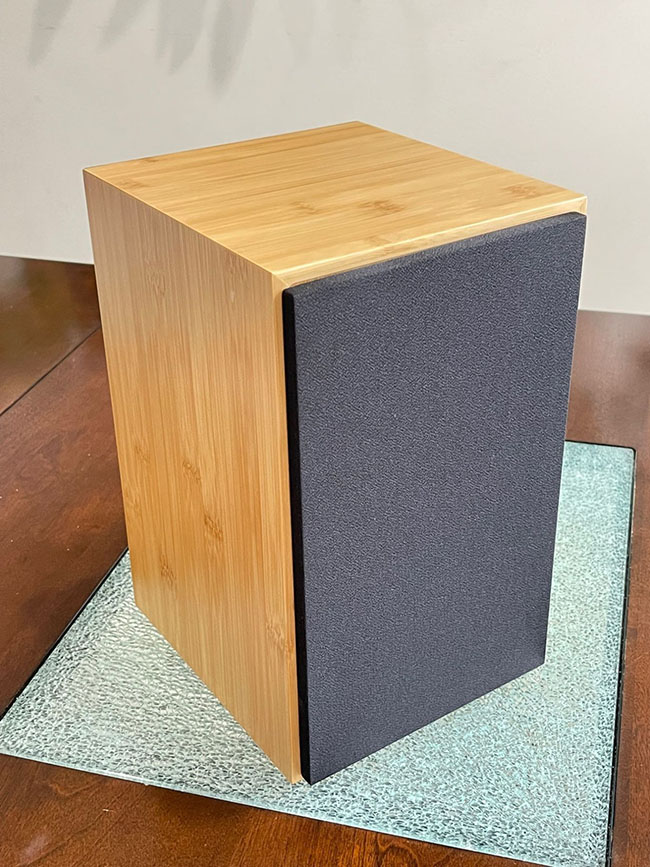
Vanguard Development

Before developing his Vanguard, Nguyen wanted to hear what the original LS 3/5a sounded like, but he didn’t want to spend the
$2700-$4000 required to snag a nice pair. Nguyen selected his drivers, built his foam prototypes, and went to work developing a crossover. To do this, he first looks at the response of the drivers to figure out where they naturally fall off and where he wants to put emphasis. “One thing that’s different with 2-way speaker designs is I move the crossover frequency rather high up. The idea here is I want to get as much energy as possible from one driver, [to] keep it coherent.” Continuing, Here’ the woofer’s doing a lot of the work.– it’s going all the way to 5.5kHz, so you’ve got this woofer covering from the bass to 5.5kHz. It’s going to have a nice coherency. The tweeter is just handling the upper treble stuff.”
The next thing Nguyen did was look at the step response of the LS 3/5a, so he located the step response from a Stereophile measurement of a Sterling LS3/5A. The designer explained, “A step response is, basically, what happens to a speaker if you were to tap it with an impulse and then let it decay. Ideally, the perfect loudspeaker would look like a right triangle; it would snap up and come right down. So, that was the shape. If you look at the step response of an LS 3/5a, it’s nice and close to a right triangle.”
Nguyen explains, “A lot of speakers that have your typical Linkwitz-Riley second order [crossover don’t] have a nice step response – [they’ll] have a couple of peaks, a delay, and looks like a mess. What that does is, if you listen to a lot of percussions, like guitars, bass, drums, the timing of [the click] versus the woofer after it, are not coherent, and so it won’t sound crisp,.. uh, but a speaker that’s time aligned, that’s transient perfect, will have its step response that will sound natural. So I saw that on an LS 3/5a and said, ‘I’m going to tune mine to match that step response.” Adding, “Even though I have a crossover frequency that’s way different than what the LS 3/5a’s doing, my step response is the same. So really, I’ve matched that speaker’s performance and character.” “If you match the step, you’re going to match the speaker’s character. “The other thing to do is actually look at the frequency response and the BBC’s LS3/5a has kind of a dip – they call it ‘the BBC dip’ – an dit also has a slight bit of emphasis at around 2kHz, to give the midrange a little more presence. And, so, all those things I sort of voiced on the crossover. At the same time, I kept the crossover really simple [with] only 6 parts versus [the] 11 on the LS 3/5a. I measure the raw response and sit there in the simulation program with the values until I get the response I want.”
The Vanguard Bookshelf Loudspeaker
 The XSA Labs site describes their Vanguard speaker as “a fresh interpretation of the classic British bookshelf monitor with a bolder and sexier sound.” With most of the sound emanating from the woofers, there’s added crispness to the imaging, body to the instrumentation, solidity to vocals, and speed to this speaker’s responsiveness. Designed as an homage to the British classic, Nguyen utilized a 130mm treated paper cone woofer and 28mm silk soft dome tweeter per cabinet. Nguyen designed an inverted Harsch transient perfect crossover, quoting the site “for snappy and time-accurate percussion and a smooth midrange in an easy to drive impedance profile that is an easy load for any amp.” The Vanguard’s passive crossover was voiced using premium components to provide a balanced non-fatiguing sound signature with superb imaging and timing. These loudspeakers are nominal 8 Ohms, 50 Wrms power handling, and 83dB at 2.83Vrms sensitivity.
The XSA Labs site describes their Vanguard speaker as “a fresh interpretation of the classic British bookshelf monitor with a bolder and sexier sound.” With most of the sound emanating from the woofers, there’s added crispness to the imaging, body to the instrumentation, solidity to vocals, and speed to this speaker’s responsiveness. Designed as an homage to the British classic, Nguyen utilized a 130mm treated paper cone woofer and 28mm silk soft dome tweeter per cabinet. Nguyen designed an inverted Harsch transient perfect crossover, quoting the site “for snappy and time-accurate percussion and a smooth midrange in an easy to drive impedance profile that is an easy load for any amp.” The Vanguard’s passive crossover was voiced using premium components to provide a balanced non-fatiguing sound signature with superb imaging and timing. These loudspeakers are nominal 8 Ohms, 50 Wrms power handling, and 83dB at 2.83Vrms sensitivity.
Master cabinet makers finely craft each Vanguard cabinet to exacting standards and materials for an heirloom-quality speaker. Each cabinet is made of solid bamboo with internal bamboo battens and features nickel-plated 5-way binding posts, a removable front baffle, and a cloth grill with magnets for a clean look. The Vanguard units I tested were built of high-quality Russian Baltic birch with a black satin painted finish and an unpainted natural birch baffle. Nguyen told me they’d offer four finishes: bamboo, brown stained birch, black paint, and an option of high gloss clear blonde birch. A limited first production run of 25 pairs is offered at an introductory price of $799/pair. After this initial run, the price will be $999/pair. XSA Labs estimates the product will be ready to deliver in the fall of 2022. These loudspeakers were extensively peer-reviewed by participants on the “Super Best Audio Friends” forum (superbestaudiofriends.org)” during a loaner tour.
Setup
Nguyen suggested using studio-monitor-foam-isolation-pads if I need to elevate the Vanguard’s height to get the tweeters at relative ear height for near-field listening at my desk. They also help reduce bounce cancellation. Fortunately, my desk is taller, with a lower pull-out and two keyboard drawers. Adding 10mm tall D’Feet under the front of each Vanguard tilted the tweeters back at a near-perfect angle. While installing, a grill loosened from its magnetic mount, and the sound I heard prompted me to remove both for slightly more energetic high-frequency enjoyment.
I’ll listen to the Vanguards at my desk near field, in my main rig, and down in our smaller “more normal” 542 sq ft. basement space to give an idea of how they sound in the average room. The grills were removed for all of my critical listening.
Listening
 Revisiting favorites with the Vanguard in a near field set up, I played Fog, a 24-96 download of Cécile McLorin Salvant’s 2015 For “One To Love” (Mack Avenue). The midrange was warm, rich, and inviting (excellent on her vocals). Transients were fast without the bite. Lows were surprisingly full-bodied and impactful, with piano tone and body weighty and commanding. Homebodies, Lee Pardini’s 2021 release (GroundUp Music), literally got me through a good part of last year with its melodic optimism, I played Whatsoever and loved how the Vanguards rendered it. The Main Title and Rancho sold me on the Vanguards – as I tweaked them into a suitable position for near-field listening. This album flies by whenever I play it, and here on the desk where I spend most of my time each day, it’s so lovely to have such an impact of quality reproduction meeting my ears. The Vanguards produce bolder, far lower frequencies than I could have imagined from a stand-mounted monitor source.
Revisiting favorites with the Vanguard in a near field set up, I played Fog, a 24-96 download of Cécile McLorin Salvant’s 2015 For “One To Love” (Mack Avenue). The midrange was warm, rich, and inviting (excellent on her vocals). Transients were fast without the bite. Lows were surprisingly full-bodied and impactful, with piano tone and body weighty and commanding. Homebodies, Lee Pardini’s 2021 release (GroundUp Music), literally got me through a good part of last year with its melodic optimism, I played Whatsoever and loved how the Vanguards rendered it. The Main Title and Rancho sold me on the Vanguards – as I tweaked them into a suitable position for near-field listening. This album flies by whenever I play it, and here on the desk where I spend most of my time each day, it’s so lovely to have such an impact of quality reproduction meeting my ears. The Vanguards produce bolder, far lower frequencies than I could have imagined from a stand-mounted monitor source.
I moved the Vanguard’s to my main rig, with the speakers on stands 30″ tall, 8 feet apart, and 5’4″ from the baffle to the front wall and a considerable distance from side walls, and played Liberty, the title track from Anette Askvik’s “Liberty” release (2011 Bird) – what I heard was revelatory. The incidental noises that floated behind the upfront performances were so very dimensional! For a second, it feels like a bird loose in the loft. Under the Vanguard’s spell, there was tremendous air around the instrumentation.
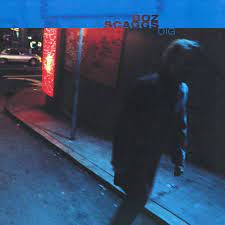 A play of Boz Scaggs’s Desire, from his album “Dig” (2001 Virgin), was a shocker with the Vanguards on stands in my main rig; surprisingly, full-throated driving bass came into the room from these 8″ deep small wonders. Vocals were rich, with great body – the entire presentation was highly well-rounded and enjoyable. I Just Go was also rich, with quick transients and convincingly low frequencies, and things held together nicely as I moved the volume up. Scaggs’ guitar was in the pocket, with a tone warmed with just a bit of breakup and his voice was warm, riding on considerable low-frequency information.
A play of Boz Scaggs’s Desire, from his album “Dig” (2001 Virgin), was a shocker with the Vanguards on stands in my main rig; surprisingly, full-throated driving bass came into the room from these 8″ deep small wonders. Vocals were rich, with great body – the entire presentation was highly well-rounded and enjoyable. I Just Go was also rich, with quick transients and convincingly low frequencies, and things held together nicely as I moved the volume up. Scaggs’ guitar was in the pocket, with a tone warmed with just a bit of breakup and his voice was warm, riding on considerable low-frequency information.
When used on speaker stands in a rig, the Vanguards seem at their best with no toe in, firing straight ahead on axis. They throw a wide and deep phantom channel image, and the speakers themselves disappear. For example, Prima Materia, from Connie Han’s soon-to-be-released “The Descent of Inanna” (2022 Mack Avenue Records II, LLC), the entire ensemble is quite far back on a stage between the Vanguards, with nothing emanating directly from either speaker. The same can be experienced on Marilyn Kleinberg’s Let Your Heart Lead the Way (2022 Waking Ip Music) featuring Will Galison – through the Vanguards, the depth and width of the phantom channel are just lovely. Badi Assad’s Waves from “Chameleon” (1998 ) is also rendered beautifully. The depth of the bass delivered by these small bookshelves is so surprising. Of course, this is dependent on setup.
On to the Basement
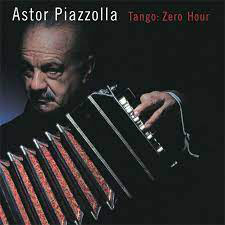 As expected, bringing the Vanguards down to the basement did not disappoint. Astor Piazzolla‘s Milongo de Angel, from his lovely Tango: “Zero Hour” (1986 American Clavé), proved lush, enveloping, and an excellent example of the heart-tugging strengths of the Vanguards. Sitting 3 1/2 feet from the back brick wall in our smaller space with an 8-foot ceiling, on 26-inch stands that were just a touch too short, and with the speakers sitting on axis, the complexity of harmonics and textures in this song was extremely well rendered. Bass was supportive, though not as bold as I expected; the speed, agility, and cohesiveness of the Vanguards impressed me the most. There is a musicality to these loudspeakers that belies their size and price.
As expected, bringing the Vanguards down to the basement did not disappoint. Astor Piazzolla‘s Milongo de Angel, from his lovely Tango: “Zero Hour” (1986 American Clavé), proved lush, enveloping, and an excellent example of the heart-tugging strengths of the Vanguards. Sitting 3 1/2 feet from the back brick wall in our smaller space with an 8-foot ceiling, on 26-inch stands that were just a touch too short, and with the speakers sitting on axis, the complexity of harmonics and textures in this song was extremely well rendered. Bass was supportive, though not as bold as I expected; the speed, agility, and cohesiveness of the Vanguards impressed me the most. There is a musicality to these loudspeakers that belies their size and price.
The Wrap
This was a long one, but I felt the need to introduce you all to Viet Nguyen, cover what makes the BBC original LS 3/5a so highly sought after, and extoll the virtues of the Vanguard Bookshelf Speakers. I found Nguyen’s development process fascinating and worthy of inclusion as well. I hope you all will give yourselves the chance to hear these speakers. Me? I want to buy a pair for near-field listening enjoyment!


greg voth
Specifications
The Vanguard Speaker
Price: $799US per pair (option of high gloss clear blonde birch finish will cost extra)
Dimensions: 7.5” W x 12” H x 8” D
Weight: 11 lbs. 4oz each
83dB @ 2.83V 1m Sensitivity
50 Wrms maximum power handling
True 8 Ohm impedance
130mm treated paper cone woofer and a 28mm silk dome tweeter
Unique inverted Harsch transient perfect crossover
Contact:
XSA Labs direct-to-you business model
Website: https://www.xsa-labs.com/
For questions, call us at (818) 584-6870
or email us at info@xsa-labs.com
Stereo Times Masthead
Publisher/Founder
Clement Perry
Editor
Dave Thomas
Senior Editors
Frank Alles, Mike Girardi, Russell Lichter, Terry London, Moreno Mitchell, Paul Szabady, Bill Wells, Mike Wright, and Stephen Yan,
Current Contributors
David Abramson, Tim Barrall, Dave Allison, Ron Cook, Lewis Dardick, John Hoffman, Dan Secula, Don Shaulis, Greg Simmons, Eric Teh, Greg Voth, Richard Willie, Ed Van Winkle, Rob Dockery, Richard Doron, and Daveed Turek
Site Management Clement Perry
Ad Designer: Martin Perry




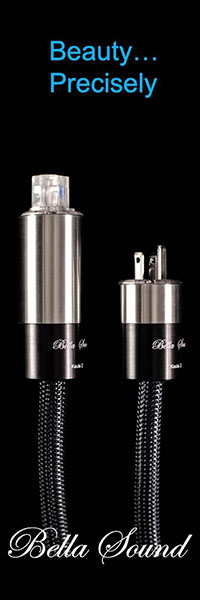

Be the first to comment on: XSA Labs Vanguard Bookshelf Loudspeakers by Greg Voth